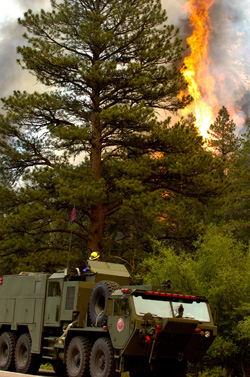Outflanking the flames: Soldiers, first responders continue integrated fight against High Park fire
Soldiers from the Colorado Army National Guard's 1157th Engineer Firefighter Company have been engaging in the attack against the High Park Fire near here, the first time the unit has been called to support a domestic emergency.

Soldiers from the Colorado Army National Guard’s 1157th Engineer Firefighter Company prepare to battle part of the High Park wildfire near Colorado Springs, Colo. The Colorado National Guard has been Soldiers and Airmen to assist with fighting the blaze in a variety of capacities ranging from military police providing site security to aviators dropping fire retardant from helicopters.
The firefighters have brought with them tactical trucks well-suited to the rugged terrain.
Unlike more familiar fire engines, their tactical firefighting trucks— officially known as heavy expanded mobility tactical trucks, but affectionately called "beasts" by their crews—roll on eight heavy-duty tractor tires for off-road maneuvering, and perfectly suited to attack fires in remote areas.
“These Soldiers are considered the incident commander's secret weapon,” said Army Lt. Col. Mitch Utterback, Colorado National Guard liaison officer to the incident management team.
From safety of the truck’s cabin, crews can conduct a mobile attack with remotely controlled bumper turrets— water cannons to the average observer—to effectively beat back flames. No hose required.
Followed by water tenders that carry 2,500 gallons each, one team from the unit has used more than 36,000 gallons of suppressants in efforts to prevent flames from crossing Poudre Canyon.
But these Soldiers aren't alone on this mission. They're fully integrated with other firefighters and under tactical control of civilian fire chiefs at two different locations.
"They understand us because of what we do in the military side, and we understand them because of what they do on the civilian side," said Sgt. 1st Class John Schreiber, fire chief and first sergeant with the unit as he described operations with civilian fire crews. "Their strategies and tactics are very similar to ours and we fit in very nicely. We all understand chain of command and span of control, so it s a natural partnership."
A team from the company is helping conduct missions in the Glacier View subdivision, where firefighters were working hard to prevent fire by containing spot fires and protecting structures.
"The first and foremost mission of any firefighter, civilian or military, is saving lives and protecting property, and that's what we're doing here," said Schreiber, who was working at the Glacier View site.
From 6 a.m. until 9 p.m. or later every day, he and his fellow Soldiers and firefighters, representing the U.S. Forest Service, the Colorado State Forest Service and several engines and crews from inside Colorado and surrounding states, are hard at work keeping the embers from crossing over the containment lines they're building.
Those that live in the area have vacated the area, said Schreiber, adding that now the focus is mitigating damage to personal property.
“We can imagine how devastating it would be to come home and find that everything we care about is gone," said Schreiber. "It's not the structure—the two-by-fours and the shingles—that matter, but the pets and the photos and the mementos that comfort that can't be replaced. Those are hugely important to us."
And rest? Schreiber is just one of many firefighters bedding down in camps scattered throughout the area of operations. For these Soldiers, rest comes in the form of sleeping bags and open air, and while they're self-sustaining in nearly every other way, bathing isn't an option. But, showers aren’t the only thing they’ve given up.
"I have a Soldier who is missing a wedding,” said Schreiber. “Another Soldier has a landscaping business that's on hold, and one is missing a job interview and not one of them has complained. They're 100 percent volunteers. These are the kinds of personalities we draw. Every time you see them, they're just happy to do their job. It's a passion."
During wildfires like this, firefighters normally get two day of rest and relaxation for every 14 days on the line - until the fire is out or contained to the extent that an incident commander can start demobilizing assets.
"It's very much like the military," said Schreiber.
And while this was the first time these Soldiers have been involved in a wildland fire, they stand ready to help again if needed, said Schreiber.
The Soldiers from the company are scheduled to assist their civilian counterparts through the end of the month.
Source: U.S. National Guard
- 309 reads
Human Rights
Ringing FOWPAL’s Peace Bell for the World:Nobel Peace Prize Laureates’ Visions and Actions

Protecting the World’s Cultural Diversity for a Sustainable Future

The Peace Bell Resonates at the 27th Eurasian Economic Summit

Declaration of World Day of the Power of Hope Endorsed by People in 158 Nations

Puppet Show I International Friendship Day 2020

